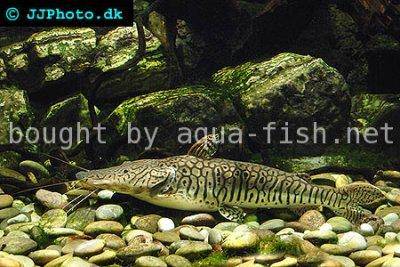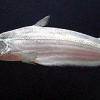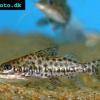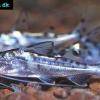Tiger shovelnose catfish - Pseudoplatystoma fasciatum
Scientific name: Pseudoplatystoma fasciatum
Common name: Tiger shovelnose catfish
Family: Pimelodidae
Usual size in fish tanks: 95 - 100 cm (37.4 - 39.37 inch)
014
Recommended pH range: 6.3 - 8
Recommended water hardness: 4 - 18°N (71.43 - 321.43ppm)
0°C 32°F30°C 86°F
Recommended temperature range: 23 - 28 °C (73.4 - 82.4°F)
The way how these fish reproduce: Spawning
Where the species comes from: South America
Temperament to its own species: peaceful
Temperament toward other fish species: aggressive to smaller
Usual place in the tank: Bottom levels
General Information
The Tiger Shovelnose Catfish (Pseudoplatystoma fasciatum) is a powerful South American pimelodid native to large river systems and floodplains. Juveniles are often sold small, but this species grows rapidly and regularly reaches 95–100 cm (38–39″) in captivity—larger in the wild. It is a strong, crepuscular–nocturnal predator and an active swimmer. Typical home aquariums are not suitable. Long-term care requires a very large, public-aquarium-scale tank or indoor pond, with robust filtration, high oxygenation, and generous turning space.
Food & Feeding
Predatory/omnivorous with a strong piscivorous bias. Offer varied, clean foods such as fish fillets, prawns/shrimp, mussels/cockles, squid, and high-quality carnivore pellets. Feed 3–4 smaller meals per week for adults; juveniles eat more frequently. Avoid mammalian/avian meats (beef heart, chicken, etc.)—their fats are poorly metabolized and can cause organ issues. Remove leftovers promptly to protect water quality.
Sexing
No reliable external differences are available to the hobbyist; sexing typically requires examination by specialists.
Breeding
Not feasible in home aquaria. In nature the species is a migratory spawner releasing pelagic eggs during high-water periods. Commercial production (where available) uses very large ponds and hormonal induction. Treat it as a display-only species in captivity.
Lifespan
Long-lived when properly housed: commonly 15 years. Growth is fast during the first years; plan for final size from day one.
Tank Requirements & Water Parameters
- Space (critical): think in meters, not centimeters. For a single adult, minimum footprint around 300 × 120 cm (10 × 4′) with exceptional filtration—larger is strongly recommended. Indoor ponds are ideal.
- Water: pH 6.3–8.0, hardness 4–18 °dH, temperature 23–28 °C (73–82 °F). Stability matters more than the absolute number.
- Filtration & oxygen: oversized mechanical biological filtration; heavy aeration and steady current. Keep ammonia/nitrite at 0 and nitrate as low as possible.
- Aquascape: wide open swimming lanes, rounded rocks/driftwood for cover, sand or smooth gravel substrate. Use a secure lid—powerful, startled leaps happen.
- Maintenance: large, frequent water changes (e.g., 30–50% weekly), careful waste management.
Compatibility & Tank Mates
With other fish it is aggressive by predation: anything that fits in its mouth will be eaten. Tank mates, if any, must be large, robust, non-nippy fishes that tolerate the same warm, flowing conditions (similarly sized pimelodids, large doradids, very large cichlids). Avoid small/medium community species entirely. Conspecifics may be quarrelsome in cramped quarters; extreme space is required for multiples.
Behaviour & Usual Place in the Tank
Most active at dusk/night; rests under cover by day. Patrols the bottom to lower-mid water column and surges upward during feeding. Provide dim areas to reduce stress.
Short Description
Tiger Shovelnose Catfish are magnificent but impractical for typical home aquaria. Expect near-meter adult size, rapid growth, heavy bio-load and a predatory nature. Only keep if you can provide a huge, well-filtered tank or indoor pond, appropriate diet, and compatible very large tank mates.
Q&A
- Will it eat other fish? Yes—if it can fit, it’s food. Plan tank mates accordingly.
- How fast do juveniles grow? Very fast under heavy feeding and warm, clean water—months, not years, to outgrow mid-size tanks.
- Is freshwater OK? Yes; it’s a freshwater species. Focus on volume, oxygen, and filtration.
Pictures
Bought by aqua-fish.net from jjphoto.dk.








 Jello
Jello  Highwaterman
Highwaterman  Spotted
Spotted  Ornate
Ornate  Pictus
Pictus